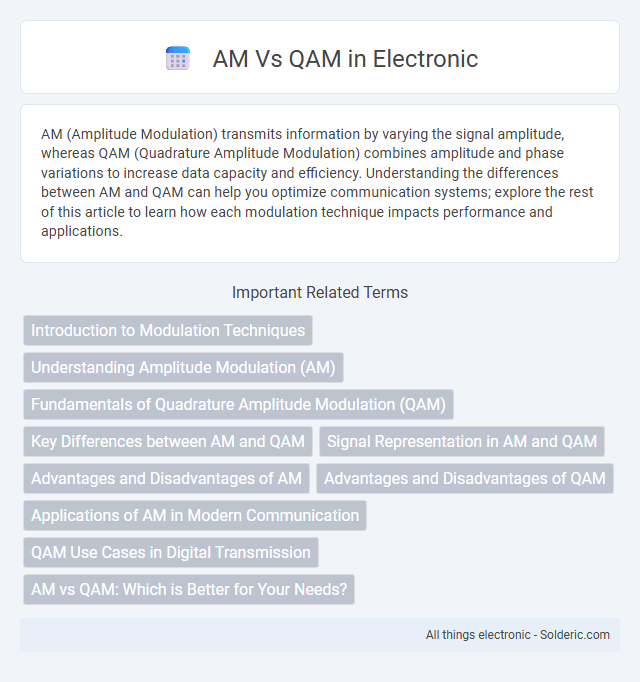AM (Amplitude Modulation) transmits information by varying the signal amplitude, whereas QAM (Quadrature Amplitude Modulation) combines amplitude and phase variations to increase data capacity and efficiency. Understanding the differences between AM and QAM can help you optimize communication systems; explore the rest of this article to learn how each modulation technique impacts performance and applications.
Comparison Table
| Feature | Amplitude Modulation (AM) | Quadrature Amplitude Modulation (QAM) |
|---|---|---|
| Definition | Modulation by varying signal amplitude | Combination of amplitude and phase modulation |
| Signal Components | Amplitude variations only | Amplitude and phase variations |
| Bandwidth Efficiency | Lower bandwidth efficiency | Higher bandwidth efficiency |
| Complexity | Simple implementation | Complex implementation |
| Noise Susceptibility | More prone to noise | Less prone to noise |
| Typical Applications | AM radio broadcasting | Digital TV, Wi-Fi, LTE |
| Data Rate | Low data rate | High data rate |
Introduction to Modulation Techniques
Amplitude Modulation (AM) alters the amplitude of a carrier wave to transmit information, commonly used in traditional broadcasting due to its simplicity. Quadrature Amplitude Modulation (QAM) combines both amplitude and phase variations to encode data, enabling higher spectral efficiency in modern digital communication systems. Your choice between AM and QAM depends on application requirements like bandwidth, noise tolerance, and data rate.
Understanding Amplitude Modulation (AM)
Amplitude Modulation (AM) varies the amplitude of a carrier wave in proportion to the message signal, enabling the transmission of information over radio frequencies. This technique is foundational for AM radio broadcasting, where the amplitude fluctuations carry audio signals that receivers decode. Understanding AM involves recognizing its susceptibility to noise and interference due to amplitude variations directly impacting signal quality.
Fundamentals of Quadrature Amplitude Modulation (QAM)
Quadrature Amplitude Modulation (QAM) combines both amplitude and phase modulation to transmit data efficiently by varying the amplitude of two carrier waves shifted by 90 degrees. This method allows QAM to encode multiple bits per symbol, significantly increasing data throughput compared to traditional Amplitude Modulation (AM). Your communication system benefits from QAM's ability to maintain higher spectral efficiency and improved noise resilience, making it ideal for modern digital transmission.
Key Differences between AM and QAM
AM (Amplitude Modulation) varies the amplitude of the carrier signal to transmit information, while QAM (Quadrature Amplitude Modulation) combines amplitude modulation with phase modulation to increase data transmission efficiency. AM typically supports lower data rates and is more susceptible to noise, whereas QAM offers higher spectral efficiency and robustness, making it ideal for digital communication systems. The complexity of QAM's signal constellation allows for multiple bits per symbol, significantly enhancing bandwidth utilization compared to the simpler amplitude variations in AM.
Signal Representation in AM and QAM
AM (Amplitude Modulation) encodes information by varying the amplitude of a single carrier signal while maintaining a constant frequency and phase. QAM (Quadrature Amplitude Modulation) combines two carrier waves shifted by 90 degrees (in-phase and quadrature components), modulating both amplitude and phase to represent multiple signal states simultaneously. Your choice between AM and QAM depends on the required bandwidth efficiency and robustness against noise in your communication system.
Advantages and Disadvantages of AM
Amplitude Modulation (AM) offers the advantage of simplicity in design and implementation, making it cost-effective for broadcasting over long distances with standard receivers. However, AM signals are highly susceptible to noise and interference, leading to lower sound quality and reduced bandwidth efficiency compared to Quadrature Amplitude Modulation (QAM). Your choice of modulation method impacts signal clarity and transmission capacity, with AM being less reliable in environments with significant electromagnetic interference.
Advantages and Disadvantages of QAM
Quadrature Amplitude Modulation (QAM) offers higher spectral efficiency compared to Amplitude Modulation (AM) by combining amplitude and phase variations to encode multiple bits per symbol. This allows QAM to support higher data rates in bandwidth-constrained environments, making it ideal for modern digital communication systems like Wi-Fi and LTE. However, QAM is more susceptible to noise and requires more complex receiver designs to accurately demodulate the signal, which can increase system cost and power consumption.
Applications of AM in Modern Communication
Amplitude Modulation (AM) remains vital in modern communication for broadcasting on the medium wave (MW) and long wave (LW) bands, used extensively in AM radio stations worldwide. AM's simple receiver design and robustness in traveling long distances make it suitable for aviation communication and international shortwave broadcasting. Its compatibility with existing infrastructure ensures AM's continued relevance despite the rise of more complex schemes like Quadrature Amplitude Modulation (QAM).
QAM Use Cases in Digital Transmission
QAM (Quadrature Amplitude Modulation) is extensively used in digital transmission for high-speed data communication, including cable modems, digital TV broadcasting, and cellular networks. By combining amplitude and phase modulation, QAM efficiently increases the bit rate within a limited bandwidth, making it ideal for broadband internet and wireless communication. Its robustness against noise and ability to carry multiple bits per symbol enable enhanced data throughput in modern digital systems.
AM vs QAM: Which is Better for Your Needs?
AM (Amplitude Modulation) offers simplicity and ease of implementation, making it suitable for basic communication needs with limited bandwidth requirements. QAM (Quadrature Amplitude Modulation) provides higher spectral efficiency by combining amplitude and phase modulation, ideal for modern high-data-rate applications such as digital TV and broadband internet. Your choice depends on whether you prioritize simplicity and cost (AM) or advanced performance and bandwidth efficiency (QAM).
AM vs QAM Infographic

 solderic.com
solderic.com